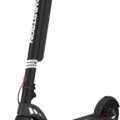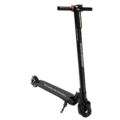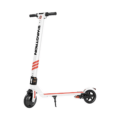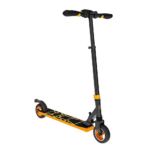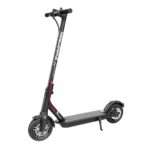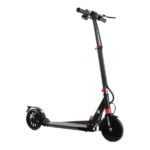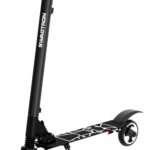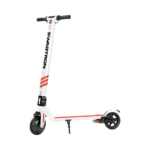- Home
- Scooters
- Electric Scooters
- Swagtron Swagger Pro
Swagtron Swagger Pro


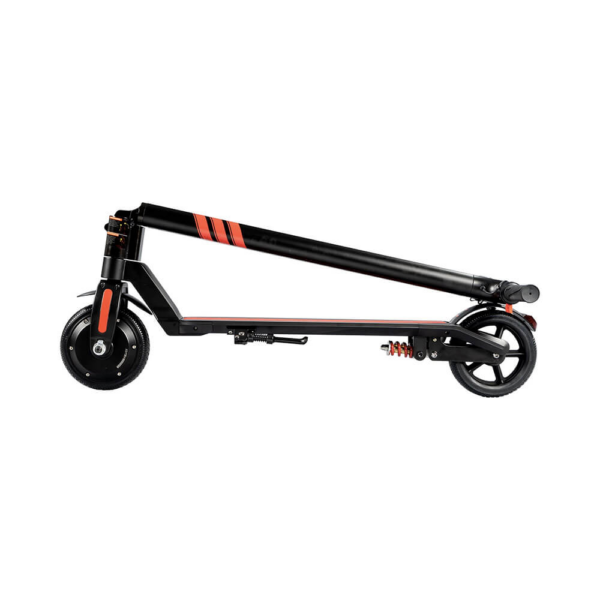

- Battery Range: 14 miles (23 km)
- Top Speed: 15.5 mph (25 km/h)
- Motor Power: 250 W
- Weight Capacity: 220 lb (100 kg)
- Charging Time: 3 hours
- Scooter Weight: 23.0 lb (10.4 kg)
PROS
- Light 23 lb (10.4 kg) folding frame for commuting
- Solid 250 W motor and 15.5 mph (25 km/h) top speed
- Rear spring suspension with 8.5-inch solid tires for low-maintenance riding
- Fast charging in roughly three hours
- Cruise control, LED headlight and USB charging port built in
CONS
- Solid tires and limited suspension still feel firm on rough roads
- Range around 14 miles (23 km) may be short for longer daily commutes
- No official IP water-resistance rating
- No companion smartphone app for ride statistics or locking


Key Takeaways
- The Swagtron Swagger Pro is a lightweight, foldable electric scooter ideal for short urban commutes.
- It features a 250 watt motor, reaches a top speed of 15.5 mph, and has a range of about 14.2 miles under optimal conditions.
- The scooter’s design includes solid rubber tires, a rear suspension, and a backlit LCD for easy control.
- Its portability makes it easy to carry and store, fitting well in crowded spaces or public transport.
- The Swagtron Swagger Pro is best for students and casual riders but may not suit heavier users or those needing to navigate steep hills.
Table of contents
The Swagtron Swagger Pro is a small, foldable electric scooter for short everyday trips. It keeps things simple. You get light weight, easy controls, and a compact frame that you can drag into a bus, office, or dorm without thinking twice. If you want a scooter that just works for city rides and campus runs, this one sits right in that zone.
What Is the Swagtron Swagger Pro?
The Swagtron Swagger Pro, often called the Swagger 3 Pro or SG-3, is a lightweight commuter scooter for teens and adults. It runs a 250 watt front hub motor and reaches about 15.5 mph, which is roughly 25 km/h, on flat ground. The rated range lands near 14.2 miles, around 23 km, when conditions are smooth and you ride at moderate speed.
The frame uses aluminum alloy and solid rubber tires. So there are no flats and almost no tire maintenance. The scooter supports riders up to about 220.5 lb, or 100 kg. At the same time, it weighs only about 23.1 lb, close to 10.5 kg. That mix makes it very easy to carry up stairs or into a trunk.
The battery sits inside the stem. That choice keeps the deck slim and leaves room for the rear suspension hardware. You roll on 6.5 inch solid tires at both ends, plus a single rear coil spring that takes the edge off small bumps and cracks. The cockpit has a backlit LCD, a thumb throttle, simple buttons for modes and lights, and cruise control. A front LED headlight and a rear light handle basic visibility at night.
In short, the Swagtron Swagger Pro feels like a small city tool. It shines on paved paths, bike lanes, and campus walkways where trips stay short and storage space can be tight.
How the Swagtron Swagger Pro Works
The core of the scooter is the 250 watt brushless hub motor in the front wheel. When you press the thumb throttle, an electronic controller sends power from the battery into that motor. Power comes on smoothly, without big jumps. Three riding modes limit top speed for new riders or let you unlock the full pace once you feel comfortable.
Inside the stem sits a 36 V lithium-ion battery rated at 6 Ah, which gives about 216 Wh of energy. That pack runs everything on the scooter. A small plug-in charger feeds it with about 42 V at roughly 1.5 A. From low charge to full charge, you usually look at around two to three hours.
The battery pack includes a battery management system. This circuit watches cell voltage and temperature and cuts power if anything drifts outside safe limits. So it protects the pack from overcharge, deep discharge, or overheating. It is not magic, but it does help the battery age more slowly in normal daily use.
Braking is simple. The left hand lever triggers an electronic brake in the front hub. The rear fender works as a foot brake. Press your heel down on it when you want extra stopping force. As soon as you touch the lever, the controller cuts power to the motor. So the motor never fights against you during a stop.
The same battery powers the lights and the display. The LCD shows speed, riding mode, and battery bars. Buttons near the screen let you turn the scooter on, change modes, switch the headlight on or off, and toggle cruise control. Once you learn the layout, the routine becomes quick. Unfold, power on, pick a mode, push off, press the throttle, and you are moving.
Design & Build Quality
The Swagtron Swagger Pro keeps the design pretty clean. The stem is slightly thick since it hides the battery, and that helps keep wires out of sight. From the front, you mostly see the stem, the fork, and the wheel. It looks simple and not flashy.
The deck has a grip surface that feels gritty, almost like fine sandpaper. Your shoes stay put when you brake or roll over rough spots. Deck length fits a natural staggered stance with one foot in front of the other. If you wear very large shoes, things feel a bit tight, yet still usable for short rides.
On the left side of the deck you find a small side kickstand. Flip it down when you park, and the scooter leans slightly to one side. Under the rear part of the deck lives the coil spring for the back wheel. That hardware gives the scooter its small dose of suspension and stays out of the way during normal riding.
The cockpit layout is simple. An LCD sits between the grips, with buttons built into the housing. You use them for power, mode changes, cruise control, and the headlight. A thumb throttle on the right controls speed. The brake lever on the left triggers the front electronic brake. Everything feels light and a bit plasticky, but that matches the scooter’s price and weight.
The folding latch at the bottom of the stem lets you drop the bar down toward the deck. Once folded, the stem hooks into the rear fender and locks in place. The folded scooter is short and tall rather than long and flat, which makes it easy to lean against a wall or slide under a desk. It is a good habit to check the latch each day and give the stem a quick tug before riding.
Bolts and joints on this scooter can loosen with time, like on most scooters in this price range. A small tool check now and then goes a long way. If you keep the hinge tight and the spring hardware secure, the build quality feels solid for daily city use.
Performance Fundamentals
On flat pavement in the top mode, the Swagtron Swagger Pro rolls up to its listed 15.5 mph without drama. The first part of the pull, up to about 10 mph, feels fairly snappy for a 250 watt scooter. After that, speed builds a bit more slowly until the controller holds you near the limit. A lighter rider feels quicker off the line. A heavier rider takes a bit longer to reach the same speed.
Noise stays modest. You hear a light electric whine from the front hub and some tire noise, then wind noise takes over around top speed. The steering stays stable, helped by the solid stem and the low deck. The front motor pulls and the rear end follows without any strange wiggle when the scooter is tightened up and well maintained.
Hill riding shows the limits of the small motor. Short ramps and mild city hills in the 7–10% range feel fine, though speed drops a little. Longer or steeper climbs slow the scooter more. Close to the top of its claimed hill rating, it can feel like a slow grind, especially for a heavier rider. So it makes sense to think of the Swagger Pro as a mostly flat city scooter with enough torque for the usual small slopes.
The three riding modes help you match the scooter to your route. Mode one keeps speed low and suits crowded paths or first rides. Mode two fits calm streets and shared bike paths. Mode three unlocks full speed for open sections. Cruise control kicks in after you hold a steady speed for a bit and tap the button, which lets you relax your thumb on longer stretches.
Overall, the Swagtron Swagger Pro gives you enough performance for short urban commutes and campus trips. It will not feel like a rocket, but it gets you from one side of town to the other at a steady, controlled pace.
Battery, Range & Efficiency
The battery setup on this scooter is pretty simple. You have a 36 V lithium-ion pack rated at 6 Ah. That gives about 216 Wh of energy, which fits the light commuter role. The published range of roughly 14.2 miles assumes mild weather, smooth pavement, a fairly light rider, and a medium speed.
In real life, most riders land somewhere in the 10–13 mile range, or 16–21 km, on flat routes. A 150–180 lb rider cruising at a moderate pace on decent pavement tends to match those numbers. Heavier riders, strong headwinds, stop and go traffic, tall hills, rough asphalt, and cold weather push that range down.
The standard charger plugs into the side of the scooter and into a wall outlet. From low to full charge you usually wait around two to three hours. That makes lunch break top-ups and overnight charging both very easy. Once the pack fills, the battery management system stops current flow so the pack does not overcharge.
A few habits help the range and battery life. Try to ride at a moderate speed when you care about distance. Fast riding uses more energy per mile. Try not to store the scooter in baking hot or freezing cold spots for long periods. Ending most rides with some charge remaining and avoiding deep empty states every single day is kinder to the cells.
For daily use, the Swagtron Swagger Pro hits a reasonable balance. The pack is small enough to keep weight down, yet large enough to cover a bunch of short trips without charging after each run. For many city riders who cover a few miles per day, that is exactly what they need.
Ride Quality & Comfort
Ride comfort on the Swagtron Swagger Pro feels firm but not harsh on good pavement. The 6.5 inch solid tires pass more vibration into the frame than larger air filled tires. The single rear coil spring softens some of those bumps, especially under your back foot, which helps a bit on patched roads and expansion joints.
Handlebar height works for a wide range of riders. Teens and average height adults get a relaxed bend in their arms. Very tall riders might feel a little hunched after long runs, yet for short rides it stays acceptable. The grips use a basic rubber pattern that gives decent traction for bare hands. Thin gloves add comfort on cooler days.
The stem feels steady at full height if the latch is tight. Side flex stays low, so the scooter does not wobble in a strange way, even near top speed. That calm front end helps new riders feel safer and gives everyone more confidence on straight runs.
The deck surface grips your shoes well. You stand with one foot a bit forward and one back, and your knees and ankles soak up some shocks. The deck sits low enough to make kick starts painless and helps the scooter feel planted during turns. If you cut across gentle curbs or small speed bumps at an angle and at low speed, the scooter clears them without big drama.
On fresh asphalt, smooth bike paths, and campus walkways, the ride feels fine for the scooter’s price and size. On very rough pavement or bumpy village roads, the solid tires remind you they are solid. Riders who deal with that kind of surface every day usually lean toward bigger scooters with larger pneumatic tires and more suspension travel.
Braking & Safety Features
The braking setup is about as simple as it gets. The front electronic brake does the main work. Pull the left lever, and the motor starts to slow the wheel through controlled resistance. For gentle stops and cruise control cancel, a light squeeze is enough.
When you need more stopping power, you press your back foot down on the rear fender. That adds direct friction at the rear wheel and shortens stopping distance. With a bit of practice, you blend the two. Start with the front electronic brake, then add the rear fender for strong stops.
Motor cut-off during braking is a key safety detail. As soon as the brake lever moves, the controller stops sending power to the motor. So the scooter never pushes forward while you try to slow down. That helps a lot on wet or dusty roads and makes emergency stops feel more controlled.
Lighting checks the main boxes. The front LED headlight sits on the stem and lights up the road directly ahead. It helps you spot bumps and lets drivers see you better. The rear light activates when the scooter moves, so traffic from behind can pick you out more easily. Adding reflective stickers on the deck or helmet and wearing bright clothing at night makes things even safer.
Water handling stays limited. The scooter deals with light splashes and a bit of drizzle, but it is not a rain bike. Deep puddles, heavy showers, or washing it with a hose are poor ideas. Water can creep into connectors and housings over time, which leads to issues later on.
Quick checks before rides go a long way. Glance at the folding latch. Try the stem for movement. Look at the rear spring hardware. Squeeze the brake lever and confirm that the scooter responds. It takes only a minute and helps keep your rides smooth and safe.
Portability & Daily Usability
Portability is one of the best parts of the Swagtron Swagger Pro. At around 23.1 lb, it feels genuinely light in one hand for most adults. Carrying it up a flight of stairs or across a train platform is not a big deal. That matters a lot if you live in a walk-up apartment or spend time on public transport.
Folding is quick. Unlock the latch, lower the stem, hook it to the rear fender, and you are done. The folded size, roughly 15 × 17 × 35.4 in, fits under desks and many tables. It leans easily in a closet or by a door. In cars, it drops into most trunks without needing to fold the rear seats.
Day to day, the scooter becomes part of your routine. Roll it out, unfold, switch it on, pick a mode, and ride. The display is readable outside, and the backlight helps at night. Cruise control is handy on long straight paths and takes pressure off your thumb.
Security needs fair thought. The frame is slim, and the wheels are small, so locking points are not perfect. A compact U-lock through the main frame tube and a fixed bike rack can work for shorter stops. For longer stops or higher risk areas, many riders take advantage of the low weight and bring the scooter indoors.
For mixed travel, the Swagger Pro fits well. You might ride three or four blocks from home to a bus stop, fold and ride the bus, then unfold and ride another stretch to work. The charger is small enough to keep in a backpack. So charging at your desk or in a dorm room turns into a simple habit.
Swagtron Swagger Pro vs Alternatives
The Swagtron Swagger Pro sits in the middle of the Swagtron family and the broader commuter scene. Against very basic budget scooters, it brings a few real upgrades. You get a rear spring, cruise control, better lighting, and a tested frame from a known brand instead of a random no-name frame.
If you look at other Swagtron models, you can place it more clearly. A model like the Swagtron Swagger 7 aims higher on power and overall spec, with features that better fit longer daily commutes. A scooter such as the Swagtron Swagger 8 shifts toward younger riders and shorter trips, with its own mix of weight, speed, and size. The Swagtron Swagger Pro stays between these types. It feels more grown up than very small kids’ scooters yet lighter and simpler than many stronger adult commuters.
Compared with mid-range scooters that carry 350–500 watt motors, bigger tires, and more suspension, the Swagger Pro feels slower and firmer. Those larger machines climb hills more easily and soak up rough roads with less shake. At the same time, they weigh more and take up more space, which makes life harder in small apartments and crowded buses.
High power and off-road scooters go way beyond it. Those big rigs use massive frames, wide air tires, and serious motors. They fly down long routes and can climb crazy hills, but they are heavy, expensive, and not fun to carry. For a rider who just wants a short city hop, that kind of scooter is overkill.
The Swagtron Swagger Pro works as a practical middle choice. It offers enough motor power for casual city speeds, a battery that fits short loops, and a frame that stays light and compact. Riders who need a scooter they can live with every day, not a machine that dominates the hallway, tend to like it.
Who the Swagtron Swagger Pro Is (and Isn’t) For
The Swagtron Swagger Pro lines up well with students, light commuters, and casual riders. If you bounce between classrooms, dorms, and coffee spots, it beats walking long distances every day. If you park a car outside the city and ride the scooter the last mile or two to the office, it saves time and sweat. The same goes for people who just want a friendly scooter for errands, quick check-ins with friends, or weekend loops around the neighborhood.
The 220.5 lb rider limit and the 23.1 lb scooter weight make it a workable match for a wide group of adults. Many people can carry it with one hand when needed. Others can roll it beside them in folded form without much effort. It is not a tiny toy, but it is far from a heavy monster either.
There are clear cases where it is not the best fit. Very tall riders might feel cramped on longer rides. People close to or above the weight limit should look at stronger models with bigger motors and frames. Riders who live in rough, hilly cities and need to climb long slopes every day will want more motor wattage and more battery capacity.
If you plan to ride 10 miles each way every weekday, this scooter starts to feel small. You can make it work with careful charging and moderate speeds, yet the margin for cold days and detours shrinks. A bigger pack and stronger motor bring more comfort for that kind of pattern.
So the Swagtron Swagger Pro shines for short to medium city rides on decent roads. It suits riders who want something light, simple, and not too expensive that still feels like a real electric scooter and not a toy. If that sounds close to your daily life, this model deserves a place on your shortlist.
Specifications
General
| Model The Model specifies the exact version or name of the scooter. It helps identify its unique design, features, and specifications within the manufacturer’s product line. Knowing the model makes it easier to compare options, find compatible accessories, or look up support information. | Swagger Pro |
| Brand The Brand identifies the manufacturer or company that designs and produces the scooter. A trusted brand is a sign of quality, reliability, and good customer support. Well-known brands often have higher standards for safety, performance, and after-sales service, giving you more confidence in your purchase. | Swagtron |
| Release Date The Release Date indicates when the scooter model was officially launched on the market. This helps you know how current the design, technology, and features are. A newer release date often means updated components, improved performance, and the latest safety or smart features. | 18 November 2025 |
| Recommended Age Recommended Age indicates the minimum age range that the scooter is designed for, based on safety, size, and ease of use. Following the recommended age helps ensure that riders can handle the scooter’s speed, weight, and controls comfortably and safely. Always check local laws and use protective gear, especially for younger riders. | +16 |
Performance & Power
| Motor Power (Wattage) What it means: The motor power, measured in watts (W), shows how strong the scooter’s electric motor is. Why it matters: Higher wattage usually means better acceleration, more torque, and improved performance on hills or rough terrain. For example, a 250W motor is good for flat city roads and light riders, while a 500W or 1000W motor provides more power for faster speeds or climbing steep inclines. | 250 W front hub motor |
| Top Speed The Top Speed indicates the maximum speed that the scooter can reach under optimal conditions. It’s usually measured on level ground with a fully charged battery and an average rider weight. A higher top speed allows you to travel longer distances faster, but always ensure you ride within legal speed limits and your personal comfort zone for safety. | Approx. 15.5 mph (25 km/h) on flat ground |
| Battery Capacity Battery Capacity refers to the total amount of energy the scooter’s battery can store, usually measured in ampere-hours (Ah) or watt-hours (Wh). A higher battery capacity means you can ride longer distances on a single charge, reducing the need for frequent recharging. Keep in mind that actual range can vary depending on rider weight, terrain, speed, and weather conditions. | 36 V 6.0 Ah (216 Wh) lithium-ion battery |
| Estimated Range per Charge The Estimated Range per Charge indicates the average distance the scooter can travel on a single full battery charge. This range is calculated under optimal conditions, such as flat terrain, moderate speed, and average rider weight. Real-world range may vary depending on riding style, terrain, weather, and load. A longer range means fewer recharges and greater freedom for longer trips. | Around 14 miles (23 km) of range per charge under ideal conditions |
| Hill Climb Ability Hill Climb Ability describes the maximum incline or slope that the scooter can handle while maintaining stable performance. It’s typically expressed as a percentage or in degrees. A higher hill climb rating means the scooter can tackle steeper hills without losing too much speed or power. Actual climbing performance may vary based on rider weight, battery charge, and terrain conditions. | Rated to climb slopes up to about 25° |
| Drive System The Drive System refers to how power from the motor is delivered to the wheels. Electric scooters typically use either a hub motor (directly integrated into the wheel) or a chain/belt drive system. A high-quality drive system ensures smooth acceleration, efficient power transfer, and low maintenance. The choice of drive system affects performance, noise level, and overall ride experience. | Front hub (FWD) |
Charging & Electrical
| Charging Time Charging Time indicates how long it takes to fully recharge the scooter’s battery from empty to 100% using the standard charger provided. Faster charging means less downtime and more time on the road. Actual charging time may vary slightly depending on battery capacity, charger output, and environmental conditions. | Fast charge in roughly 3 hours from empty |
| Battery Type Battery Type refers to the specific technology used in the scooter’s battery, which affects performance, lifespan, weight, and charging time. Most modern electric scooters use high-quality lithium-ion (Li-ion) batteries because they offer a good balance of energy density, durability, and low maintenance. A reliable battery type ensures consistent power delivery and longer riding ranges. | Lithium-ion battery pack with basic BMS protection |
| Removable Battery A Removable Battery means the battery pack can be easily detached from the scooter for convenient charging and replacement. This feature allows you to charge the battery separately, swap it with a spare for extended range, or securely store it indoors in extreme weather. Removable batteries add flexibility and make it easier to keep your scooter powered up wherever you are. | Non-removable internal battery pack |
| Regenerative Braking Regenerative Braking is an energy-saving feature that converts some of the energy normally lost during braking back into battery power. When you slow down or brake, the motor works in reverse to generate electricity, which helps extend the scooter’s range and improves overall efficiency. This system also reduces wear on traditional brake components, leading to lower maintenance over time. | No explicit regenerative braking system documented |
| Lighting Lighting refers to the built-in front and rear lights that enhance visibility and safety when riding in low-light conditions or at night. Good lighting helps you see the road ahead and ensures that other road users can see you. Many scooters include LED headlights, taillights, and sometimes brake lights or side reflectors for added safety and compliance with local traffic regulations. | Integrated LED headlight and rear reflectors; backlit handlebar display |
Build & Dimensions
| Scooter Weight Scooter Weight refers to the total weight of the scooter when fully assembled, including the battery. This affects how easy it is to carry, lift, and store the scooter when not in use. A lighter scooter is more portable and convenient for commuting, especially if you need to carry it upstairs or onto public transport. Keep in mind that a sturdy frame and quality components may add to the weight but also contribute to better durability and ride stability. | 23.0 lb (10.4 kg) folding aluminum scooter |
| Maximum Rider Weight Maximum Rider Weight indicates the highest rider weight that the scooter is designed to safely support while maintaining optimal performance and stability. Staying within this limit helps ensure reliable acceleration, braking, and climbing ability, and it protects the frame, suspension, and motor from excessive strain. Exceeding the recommended limit may reduce performance and increase wear on components. | 220 lb (100 kg) max rider weight |
| Deck Size Deck Size refers to the dimensions of the scooter’s standing platform. A wider and longer deck provides more foot space, allowing you to stand comfortably and adjust your stance while riding. A well-sized deck improves balance and stability, especially on longer rides or at higher speeds. Compact decks, on the other hand, help keep the scooter lightweight and portable. | Aluminum alloy commuter frame with rear suspension and narrow deck |
| Handlebar Height Handlebar Height refers to the distance from the deck to the handlebars, which affects your riding posture and comfort. An appropriate handlebar height helps you maintain good balance, reduces strain on your back and arms, and makes steering more comfortable. Some scooters have adjustable handlebars to fit riders of different heights, while others have a fixed height for a streamlined design. | Fixed-height handlebar suitable for most teens and adults |
| Folding Mechanism The Folding Mechanism describes how easily and securely the scooter can be folded for carrying and storage. A well-designed folding system lets you quickly collapse the scooter into a compact size, making it convenient to transport on public transit, store under a desk, or fit into a car trunk. Look for sturdy latches and safety locks to ensure the scooter stays firmly in place when folded or unfolded. | Quick-folding stem with locking latch for compact storage |
| Dimensions Folded Dimensions indicate the size of the scooter when it’s fully folded. This measurement shows how much space the scooter will take up when stored or carried, making it easier to check if it will fit in your car trunk, under a desk, or in a closet. Compact folded dimensions are ideal for commuters who need to bring their scooter on public transport or store it in tight spaces. | Unfolded: 41.3 × 17.0 × 35.4 in (104.9 × 43.2 × 89.9 cm). Folded: 35.4 × 17.0 × 15.0 in (89.9 × 43.2 × 38.1 cm). |
| Material Material refers to the primary construction materials used for the scooter’s frame and key components. High-quality materials like aircraft-grade aluminum, reinforced steel, or durable composites provide strength, stability, and a lighter overall weight. A sturdy material ensures the scooter can handle daily wear and tear while maintaining safety and performance. | Aluminum alloy frame with solid rubber tires |
Safety & Control
| Brake Type(s) Brake Type(s) describe the braking systems the scooter uses to help you slow down or stop safely. Common brake types include mechanical brakes (like drum or disc brakes), electronic brakes, and foot brakes. Many scooters combine multiple braking systems for added safety and shorter stopping distances. The type and quality of brakes affect your control, especially when riding at higher speeds or on slopes. | Dual braking system with front electronic brake and rear friction foot brake using Autoguard cut-off |
| Suspension Suspension refers to the system that absorbs shocks and vibrations while riding, providing a smoother and more comfortable ride over uneven or rough surfaces. Scooters may have front suspension, rear suspension, or dual suspension for better shock absorption and stability. Good suspension helps reduce rider fatigue and improves control, especially when riding on bumpy roads or off-road paths. | Rear coil-sprung suspension; no front suspension |
| Tire Type Tire Type refers to the kind of tires the scooter uses, which directly affects ride comfort, traction, and maintenance. Common types include solid (airless) tires, pneumatic (air-filled) tires, or hybrid options. Pneumatic tires offer better shock absorption and a smoother ride on rough surfaces, while solid tires are puncture-proof and require less upkeep. The right tire type helps ensure safe handling and a comfortable ride in different conditions. | 8.5-inch solid rubber tires designed to avoid flats |
| Tire Size Tire Size indicates the diameter and width of the scooter’s tires, which affect ride comfort, stability, and how well the scooter handles different terrains. Larger tires generally offer better shock absorption and a smoother ride over bumps and rough surfaces, while smaller tires keep the scooter lighter and more portable. Choosing the right tire size helps ensure a balance between agility and comfort. | Wheel size: 8.5-inch solid tires |
| Kickstand The Kickstand is a built-in stand that allows you to park your scooter upright when it’s not in use. A sturdy kickstand keeps the scooter stable and prevents it from tipping over, protecting it from scratches and damage. It also makes storing and accessing your scooter more convenient, whether you’re at home, work, or on the go. | Side kickstand for upright parking |
| Water Resistance Rating Water Resistance Rating indicates how well the scooter is protected against water and moisture, usually shown as an IP (Ingress Protection) rating. This rating helps you understand whether the scooter can handle light rain, splashes, or wet roads without damage. While most scooters are not fully waterproof, a good water resistance rating adds peace of mind when riding in changing weather conditions. Always avoid deep puddles or submerging the scooter to protect its electrical components. | IP rating: Not specified |
Features & Extras
| Display/Console The Display (or Console) shows important real-time information about your ride, helping you monitor your scooter’s status at a glance. Typical displays show speed, battery level, distance traveled, and riding mode. Some models also include additional features like Bluetooth connectivity, app integration, or backlighting for better visibility at night. A clear and easy-to-read display enhances safety and convenience on every trip. | Backlit LCD-style dashboard with speed, battery level, mode and cruise indicator |
| Ride Modes Ride Modes refer to the different speed and power settings you can choose to match your riding style or road conditions. Common modes include eco for maximum range and energy efficiency, standard for everyday balance, and sport or turbo for higher speed and stronger acceleration. Switching between ride modes allows you to customize performance, conserve battery, and ride safely in various environments. | Three riding modes plus cruise control selectable from the handlebar controls |
| Smart App Connectivity Smart App Connectivity lets you pair your scooter with a dedicated mobile app via Bluetooth. Using the app, you can monitor real-time ride stats like speed, battery level, and range, adjust settings such as ride modes or cruise control, lock the scooter for added security, and sometimes receive firmware updates. This feature adds convenience and allows you to personalize your riding experience right from your smartphone. | No dedicated smartphone app; settings adjusted from the onboard console |
| Anti-Theft System The Anti-Theft System helps protect your scooter from unauthorized use or theft. This feature can include built-in alarms, electronic motor locks, GPS tracking, or remote locking through a mobile app. A good anti-theft system provides peace of mind when parking your scooter in public spaces, adding an extra layer of security to safeguard your investment. | Relies on basic keyless power-on; external lock recommended for security |
| Cruise Control Cruise Control allows you to maintain a steady speed without continuously holding the throttle. This feature makes longer rides more comfortable by reducing hand fatigue and providing a smoother, more relaxed riding experience — especially on flat, open roads or bike lanes. For safety, cruise control can usually be easily activated or deactivated while riding. | Cruise control available once a steady speed is maintained |
| Accessories Included Accessories Included lists the additional items that come with the scooter to enhance your riding experience and convenience. Common accessories may include a charger, kickstand, bell, lights, phone holder, or carrying strap. These extras add value by making your scooter safer, easier to use, and ready to ride straight out of the box. | Includes scooter, 42 V ~1.5–2 A charger, kickstand and manual |
Warranty & Compliance
| Warranty Period The Warranty Period indicates how long the manufacturer guarantees the scooter against defects in materials and workmanship under normal use. A good warranty provides peace of mind, showing the brand’s confidence in its product quality. Always check what parts are covered, such as the frame, battery, and motor, and follow the maintenance guidelines to keep your warranty valid. | Typically 12-month limited warranty on scooter and battery (region-dependent) |
| Certifications Certifications confirm that the scooter meets specific safety, quality, and environmental standards set by recognized organizations or regulatory bodies. Common certifications may include CE, RoHS, UL, or other local compliance marks, depending on your region. These certifications ensure that the scooter is manufactured to high standards and is safe and legal to use in your country. | No specific road-homologation noted; marketed as a consumer electric kick scooter |
Price Comparison




